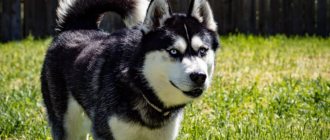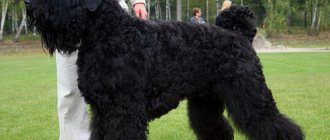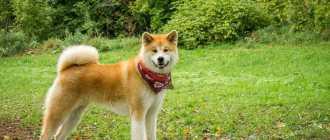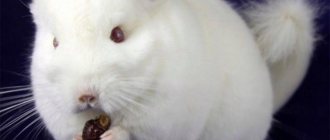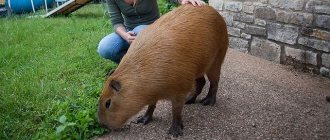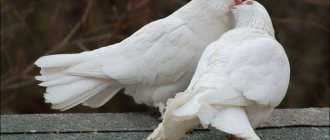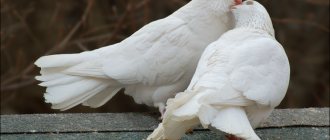China is a country shrouded in legends and secrets, so it is not surprising that Chinese dog breeds amaze us with their amazing characteristics.
In China, dogs are considered symbols of prosperity and wealth, and were originally bred to guard monasteries and as companions for the emperors of Ancient China. Because of their religious roots, many Chinese dog breeds were considered sacred, and most were not influenced by foreign dog breeds. This is one of the many reasons why Chinese dogs have a completely unique appearance.
From Lhasa Apsos and Chow Chows to rarer breeds with centuries of history, we've rounded up the most popular dogs native to China.
Chinese Crested Dog
- Height: from 28 to 33 cm
- Weight: from 3.6 to 5.5 kg
- Life expectancy: 13 to 18 years
- Average cost: from 1200 to 2200 dollars
Those prone to runny noses and sore throats may enjoy the Chinese Crested Dog, a “hypoallergenic” hairless dog breed that typically weighs no more than 5.5 kg. While no dog is truly hypoallergenic, this breed has a very low level of allergens.
Interesting fact: Chinese crested dogs were often taken on voyages to help prevent the spread of black plague on ships, because they quickly caught bilge rats.
The Chinese Crested Dog comes in two varieties : almost hairless with soft, smooth skin and tufts of hair on the head, paws and tail; and completely covered with soft, silky fur. Interestingly, there are very few differences between the two varieties and both can be born in the same litter.
Chinese crested dogs make up for their small size with their striking appearance and devotion to their owners, often serving as ideal companions for a comfortable holiday. Their small bodies also have a lot of vitality - they are a long-lived breed with a lifespan of up to 18 years.
Although Chinese Crested dogs do not shed, the hairless variety can be susceptible to skin irritation and should be protected with sunscreen when outdoors. It is also worth noting that the Chinese Crested Dog is sometimes called a “cat dog” because, like a cat, it likes to climb high objects.
Chow chow
- Height: from 43.2 to 50.8 cm
- Weight: from 20.4 to 32 kg
- Life expectancy: 8 to 12 years
- Average cost: from 1000 to 4000 dollars
Associated with China's Han Dynasty, the Chow Chow is one of the oldest living dog breeds, dating back to the 11th century BC . Even ancient Chinese artifacts have been discovered depicting this mighty breed. The Chow Chow is a versatile dog breed. Its original purpose was hunting, herding and protection. It gained worldwide popularity only in the 18th century, when representatives of this breed fell into the hands of the British.
Fun fact: This is one of only two dog breeds with a blue-black tongue, a special characteristic only shared by the Chinese Shar-Pei.
With its frowning face and fluffy fur, the Chow Chow has a very distinct bear-like appearance . Socialization and training at an early age are important for this breed. In warm weather, exercise should be limited as the pet can easily overheat, but in cooler months the Chinese Bear Dog should be walked regularly.
Content
The ideal conditions for keeping a pet would be a spacious enclosure with a warm kennel or a closed local area with the ability to hide in an equipped kennel. Keeping the dog in a spacious house or apartment is also suitable, but in this case you will need to walk the dog regularly twice a day.
Important! You need to walk your dog for at least 2-3 hours every day, and preferably more. Otherwise, damage to the animal owner's property may be caused.
Feeding is another important aspect of keeping a pet. Due to the large admixture of wild wolf blood, animals of this breed are not adapted to balanced dry food. It is better to use natural feeding with meat and protein products. Nutrition must be competent and balanced so that the pet receives all the necessary vitamins and microelements.
The Chinese German Shepherd is a separate breed, recognized in the country in 1988. They are noticeably different from their purebred relatives, but at the same time they have many similar traits.
Chinese Shar Pei
- Height: from 45.7 to 50.8 cm
- Weight: from 20.4 to 27.5 kg
- Life expectancy: 8 to 12 years
- Average cost: from 1000 to 1500 dollars
The Chinese Shar Pei was also developed during the Han Dynasty, but has a more troubled past than the Chow Chow. The breed was on the verge of extinction in 1949 when the communist regime after the founding of the People's Republic of China opposed dog ownership. Fortunately, the Chinese Shar Pei survived and was officially recognized in 1992.
The Chinese Shar Pei performs best when it can make its own decisions, so it is important to prioritize obedience training with positive reinforcement to help your pet respond correctly to your cues.
Along with their blue-black tongue, these dogs are also famous for their wrinkled appearance. They should be bathed monthly and the folds between the wrinkles should be kept dry and clean. Ear cleaning is a priority and should be done weekly using a cleaning solution recommended by your veterinarian.
Chongqing
A dog that deserves special attention. This is a long-liver (20 years), whose pedigree dates back 2000 years ago. It is very rare to meet this representative outside the country, since the species is quite rare.
Chongqing is unique in its resemblance to the Chow Chow (blue tongue) and the abundance of folds with the Shar Pei. This is a large dog, whose height can reach 50 centimeters, see photo. The peculiarity is the virtual absence of wool.
Initially, they were exclusively dogs for hunting, because their character was heavy and dominant. This is especially evident in the lack of training. By taming the Chongqing, you can get a devoted comrade with whom you are not afraid to leave small children.
Japanese Chin
- Height: from 20.5 to 28 cm
- Weight: from 3.2 to 5 kg
- Life expectancy: 10 to 12 years
- Average cost: from 1200 to 2000 dollars
Yes, you read that right! Despite its name, the Japanese Chin is believed to have originated in China and long flourished among Buddhist monks and emperors. Its introduction to Japan ultimately shaped the breed as we know it today.
The Japanese Chin is a cute lap dog with a calm disposition . It is well suited for apartment living. Companionship is what Japanese Chins were bred for. They will be happy to spend the whole day next to you or on your lap.
Varieties of branched onions
Several varieties of the crop are known. The most popular are:
- Aprior. The variety is suitable for different Russian regions, is mid-early and frost-resistant. The greens are dark green and juicy, reaching 30 cm in height and 1 cm in width. You can collect 2-3 kg of greens per square meter in 3 cuts.
- Fragrant. The greenery appears early, the feathers reach 30 cm, have a dark green color and a waxy coating. A square meter of planting provides up to 4.5 kg of greenery.
- Benefit. The variety is mid-season and frost-resistant. The feathers reach 40 cm in height and have a garlicky aroma. You can collect up to 4.5 kg of greens per square meter.
- Jusay. The feather reaches 30 cm in height, has a delicate taste and a subtle garlic smell. A square meter brings up to 3 kg of greenery.
- Astrologer. Mid-season variety, greens are used fresh. The height of the feather reaches 50 cm, the greenery is abundant, and has a waxy coating. The harvest can be obtained earlier than with other varieties; a square meter of planting brings up to 3 kg of greenery.
- Caprice. Mid-season salad variety. The feather is wide, grows up to 50 cm, has a dark green color, a slightly pungent taste and a garlicky smell. A square meter of planting provides up to 3 kg of greenery.
- Spicy. The variety is mid-season and is considered a salad variety. The feather is juicy, dark green in color, and has a delicate taste with garlic notes. A square meter of planting yields up to 3.5 kg of greenery.
Lhasa apso
- Height: from 25.4 to 28 cm
- Weight: from 5.5 to 8.5 kg
- Life expectancy: 12 to 15 years
- Average cost: from 1500 to 2500 dollars
This Chinese dog breed dates back thousands of years and was originally used to protect Buddhist monasteries in the Himalayas. The Lhasa Apso is considered one of the most sacred breeds in China and was only allowed to leave the country if it was gifted by the Dalai Lama as a symbol of good luck and prosperity. The first pair of Lhasa Apsos were sent to the United States as a gift to researcher S. Suydam Cutting in 1933, and soon the whole world fell in love with this long-haired dog.
Fun fact: In Tibetan folklore, the protector of China is the mythical Snow Lion, and the Lhasa Apso, the “bearded lion dog ,” is the earthly representative of the Snow Lion. "Lhasa" is the name of the holy city of Tibet; "apso" means "long-haired dog."
Despite their relatively small stature, these Chinese "lion dogs" live up to their nickname by always keeping a watchful eye on their family members. What could be even better? The Lhasa Apso can be your canine companion for 12-15 years.
Pekingese
- Height: from 15.3 to 23 cm
- Weight: up to 6.5 kg
- Life expectancy: 12 to 14 years
- Average cost: from 750 to 1500 dollars
Legend has it that Buddha created the Pekingese by shrinking a lion. Well known for its regal mane and fluffy fur, the Pekingese was considered sacred by the imperial family of the Tang Dynasty in the 8th century.
Fun fact: Pekingese are named after Beijing. Initially, only members of the royal family could own them, and theft was punishable by death.
An inflated ego is still present in the breed today, and the Pekingese is sure to become the king or queen of your home. Since the Pekingese is a brachycephalic breed , it is important to keep it away from the heat. Veterinarians recommend taking an ice pack or a portable fan with you on walks in the summer to cool your four-legged friend.
Pug
- Height: from 25.4 to 33 cm
- Weight: from 6.3 to 8.2 kg
- Life expectancy: 13 to 15 years
- Average cost: from 800 to 1500 dollars
Many people are often surprised to learn that the pug is a Chinese dog. The breed probably dates back more than 2,000 years ago . Pugs were bred as companions to Buddhist monks, and emperors and royalty kept pugs as valued family members. Today, due to their affectionate nature and funny appearance, pugs continue to be the ideal family dog.
Fun fact: The Pug's motto is the Latin phrase "multum in parvo" ("much in little") - an apt description of this small but muscular breed.
Pugs are always happy, whether they live in the city or in the countryside, with children or the elderly, kept as the only pet or have four-legged friends. Pugs naturally do not tolerate heat well and should not exercise in warm or humid weather.
Training and education
Very trainable, quite versatile, with good guarding qualities and excellent instincts, distrustful of strangers, suitable both for service and sports, and as a companion to experienced people. It is better to start training as soon as the puppy moves to you - first at home, then after all vaccinations, classes with an experienced instructor are recommended.
- The direction of training must be chosen based on the puppy’s temperament and inclinations. Socialization begins as early as possible, periodically visiting crowded places with the dog, introducing them to transport, various noises and giving the opportunity to communicate and play with their own kind.
When choosing the gender of a Chinese Shepherd, it is important to take into account that males have a tougher character and are prone to fights with their relatives; this requires more attention from the owner to education.
Price
The cost of the puppy will depend on the breed type and origin, and ranges from 500 to 2000 euros, not including delivery, if the dog is purchased from local Chinese kennels. In Russia and neighboring countries, the Chinese Shepherd is very rare and is not popular.
When buying a puppy, you should be sure to conclude a sales contract in English and ask the breeders for confirmation of origin and pictures of the parents for joint dysplasia.
Export from the country is possible one month after rabies vaccination with a full set of accompanying veterinary documents and an export permit.
Shih Tzu
- Height: from 23 to 28 cm
- Weight: from 4 to 7.3 kg
- Life expectancy: 10 to 18 years
- Average cost: from 1000 to 1800 dollars
This incredibly popular little dog was developed around 1000 BC in ancient China, where they were kept as royal pets. The Shih Tzu was bred as a cross between the Lhasa Apso and the Pekingese.
Shih Tzu literally translates to "little lion" . Legend has it that Buddha had a small Shih Tzu, and one day while he was traveling, robbers ambushed him with the intention of robbing him and killing him. To protect its owner, the little dog turned into a huge lion and scared away the criminals!
Being cute is the goal of this adorable dog's life. Shih Tzus are known to be especially affectionate with children. As a small dog bred to spend most of its day in royal palaces, it makes a great pet if you live in an apartment or have a large backyard. Shih Tzus get along well with cats and other dogs, making them ideal furry pets.
General information
Two words can describe the appearance of dogs from the East: pretty exotic. The Chinese Akita dog is a clear confirmation of the previous sentence. They say the Akita was bred in the land of the rising sun, but most of the time, Chinese dynasties raised their own loyal dog for themselves.
REFERENCE! All dogs of Chinese and Japanese origin are loyal. Having grown up in complete isolation and control, they have a desire to conquer freedom, new heights, but will never leave their owner. These animals develop a “habit of their owner” from birth, which does not leave them throughout their lives. REFERENCE!
Tibetan Terrier
- Height: from 35.5 to 43.2 cm
- Weight: from 8.2 to 13.6 kg
- Life expectancy: 15 to 16 years
- Average cost: from 1000 to 1500 dollars
Referred to as the "sacred dog of Tibet" , this Chinese dog has been associated with ancient Buddhist monasteries and the Dalai Lama, serving a variety of roles as companions, watchdogs and shepherds. They are believed to be native to the Lost Valley of Tibet.
Fun fact: the Tibetan Terrier is not actually a terrier at all. This name was given by European travelers who felt that this breed was very similar to European terriers.
The Chinese believe that the Tibetan Terrier brings good luck . Of course, anyone who owns one of these long-haired beauties feels lucky, as they are a highly adaptable breed well suited to family life. Tibetan Terriers thrive on human contact and make excellent therapy dogs.
With a protective double coat of fur and large, flat, round feet that provide excellent traction—almost like snowshoes—Tibetan Terriers are well suited to life in snowy regions.
Tibetan Spaniel
- Height: from 21 to 26 cm
- Weight: from 4.1 to 6.8 kg
- Life expectancy: 12 to 15 years
- Average cost: from 1500 to 3500 dollars
The Tibetan Spaniel is another very old Chinese dog breed, and it's not actually a spaniel either! Bred in the Himalayas almost 2,500 years ago, the Tibetan Spaniel was one of the best watchdogs of Buddhist monasteries. Despite his small stature, the Tibetan spaniel did his job well - the dogs sat high on the walls and barked loudly when strangers approached. Thanks to its innate protective instincts, the Tibetan Spaniel will be an attentive and excellent protector of the home.
Tibetan mastiff
- Height: from 61 to 66 cm
- Weight: from 32 to 68 kg
- Life expectancy: 10 to 12 years
- Average cost: from 2000 to 6000 dollars
Many Tibetans believe that Tibetan mastiffs are the receptacle for the souls of monks and nuns who were not reborn as humans or did not enter the heavenly kingdom. Impressively large in size, this Chinese dog was primarily used to guard Himalayan villages and their inhabitants. This breed is said to have protected Alexander the Great and even the Dalai Lama!
Fun fact: the most expensive dog is the Tibetan Mastiff, which sold for almost $2 million in 2014.
a status symbol in China and is therefore one of the most expensive dog breeds. But, despite the thick double coat, Tibetan mastiffs do not require as much care as other breeds, but have a strong shedding season in spring or summer.
Health
They can live 10-12 years . The length of life depends on its quality. They have excellent health, but there are a number of diseases inherent in them. Among them: cancer, problems with the digestive system and musculoskeletal system, cataracts, corneal dystrophy, joint dysplasia, growth hormone deficiency, epilepsy, pericardium, pyoderma, dermatitis.
Unfortunately, the list is not short and these are real diseases that are most often inherent in the breed. But if you take proper care of your dog and undergo all necessary examinations on time, then no problems should arise.
It is also recommended to purchase puppies from nurseries, as they only sell healthy pets. Although these diseases are predominantly not hereditary, puppies may already have some of them at birth.
Taiwanese dog
- Height: from 43 to 52 cm
- Weight: from 12 to 18 kg
- Life expectancy: 10 to 13 years
- Average cost: $3,000 to $4,000
This is one of the rarest dogs on our list. At one point, this Chinese dog breed was on the verge of extinction due to insufficient conservation efforts, which were exacerbated by the dog-eating culture introduced by the Chinese Nationalist Party in 1945. Today, purebred Taiwanese dogs are rare and are mostly limited to Taiwan to preserve the breed. However, many crossbreeds can be found freely in markets.
Xiaxiquan
- Height: from 43.2 to 50.8 cm
- Weight: from 10 to 30 kg
- Life expectancy: 12 to 14 years
- Average cost: unknown
These hunting dogs from China's southern Guizhou province are another Chinese dog breed that is critically endangered , with fewer than a few hundred left in the area today. Xiaxi Quan dogs were a respected breed, primarily used as hunting and guard dogs. They were also considered good luck talismans that brought wealth and prosperity to the homes of their owners.
What to feed?
Due to the natural origin of the breed, its representatives should be fed only natural food. The animal's diet must include turkey, beef, chicken and lamb, as well as heart, liver, kidneys, tripe and other offal. Moreover, the share of meat should be at least 50% of the total volume, and the second half of the diet should consist of buckwheat, rice or pearl barley.
We suggest you familiarize yourself with: Black French Bulldog
Vegetables should also be on the menu. Moreover, they can be given both raw and baked. The most beneficial for the dog's body are spinach and lettuce leaves, pumpkin, cabbage, beets and zucchini. Twice a week you can give lean fish, pre-cooked and cleaned of large bones, and eggs.
Of course, you can’t offer whole milk, but fermented milk products will come in very handy. The dog will happily eat cottage cheese mixed with raw yolk and hard cheese. The animal can sometimes be pampered with dried pork and beef ears, trachea and chewing bones made from pressed veins. Under no circumstances should you feed your dog peas, beans, potatoes, corn, pickles, smoked meats, as well as bread, sweets and baked goods.
As for the frequency of meals, puppies need to be fed 5-6 times a day. For an adult animal, 2 meals a day will be enough. Bone meal, fish oil, vitamins and minerals should be given as a food supplement.
